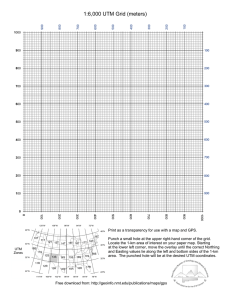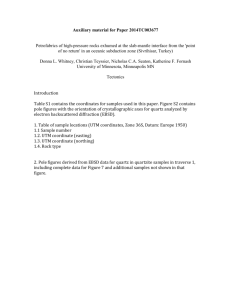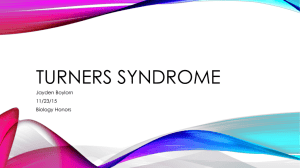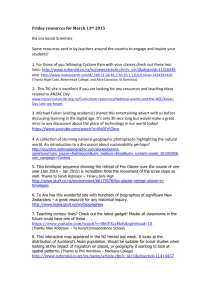Research Note RM-483 Recording Wildlife Locations with the Universal ~ransverse
advertisement
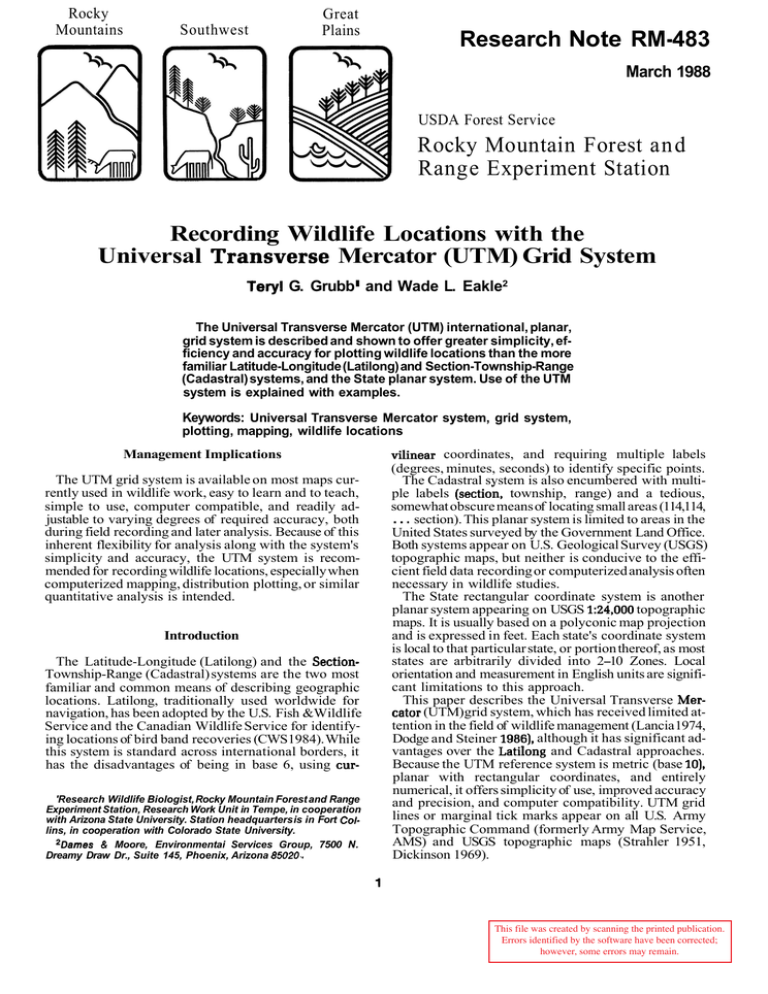
Rocky Mountains Southwest Great Plains Research Note RM-483 March 1988 USDA Forest Service Rocky Mountain Forest and Range Experiment Station Recording Wildlife Locations with the Universal ~ransverseMercator (UTM) Grid System Teryl G. Grubbl and Wade L. Eakle2 The Universal Transverse Mercator (UTM) international, planar, grid system is described and shown to offer greater simplicity, efficiency and accuracy for plotting wildlife locations than the more familiar Latitude-Longitude (Latilong) and Section-Township-Range (Cadastral) systems, and the State planar system. Use of the UTM system is explained with examples. Keywords: Universal Transverse Mercator system, grid system, plotting, mapping, wildlife locations Management Implications The UTM grid system is available on most maps currently used in wildlife work, easy to learn and to teach, simple to use, computer compatible, and readily adjustable to varying degrees of required accuracy, both during field recording and later analysis. Because of this inherent flexibility for analysis along with the system's simplicity and accuracy, the UTM system is recommended for recording wildlife locations, especially when computerized mapping, distribution plotting, or similar quantitative analysis is intended. Introduction The Latitude-Longitude (Latilong) and the SectionTownship-Range (Cadastral) systems are the two most familiar and common means of describing geographic locations. Latilong, traditionally used worldwide for navigation, has been adopted by the U.S. Fish &Wildlife Service and the Canadian Wildlife Service for identifying locations of bird band recoveries (CWS1984). While this system is standard across international borders, it has the disadvantages of being in base 6, using cur'Research Wildlife Biologist, Rocky Mountain Forest and Range Experiment Station, Research Work Unit in Tempe, in cooperation with Arizona State University. Station headquarters is in Fort Collins, in cooperation with Colorado State University. 2Dames & Moore, Environmentai Services Group, 7500 N. Dreamy Draw Dr., Suite 145, Phoenix, Arizona 85020.. vilinear coordinates, and requiring multiple labels (degrees, minutes, seconds) to identify specific points. The Cadastral svstem is also encumbered with multiple labels (sectio'h, township, range) and a tedious, somewhat obscure means of locating small areas (114,114, . . . section). This planar system is limited to areas in the United States surveyed by the Government Land Office. Both systems appear on U.S. Geological Survey (USGS) topographic maps, but neither is conducive to the efficient field data recording or computerized analysis often necessary in wildlife studies. The State rectangular coordinate system is another planar system appearing on USGS 1:24,000 topographic maps. It is usually based on a polyconic map projection and is expressed in feet. Each state's coordinate system is local to that particular state, or portion thereof, as most states are arbitrarily divided into 2-10 Zones. Local orientation and measurement in English units are significant limitations to this approach. This paper describes the Universal Transverse Mercator (UTM)grid system, which has received limited attention in the field of wildlife management (Lancia 1974, Dodge and Steiner 1986),although it has significant advantages over the Latilong and Cadastral approaches. Because the UTM reference system is metric (base lo), planar with rectangular coordinates, and entirely numerical, it offers simplicity of use, improved accuracy and precision, and computer compatibility. UTM grid lines or marginal tick marks appear on all U.S. Army Topographic Command (formerly Army Map Service, AMS) and USGS topographic maps (Strahler 1951, Dickinson 1969). This file was created by scanning the printed publication. Errors identified by the software have been corrected; however, some errors may remain. System Description The UTM system is an international, plane (rectangular), coordinate system developed by the U.S. Army for both military and civilian use (U.S. Army 1969). From 84 degrees North to 80 degrees South, the world is divided into 60 Zones, each covering 6 degrees longitude. (The comparable Universal Polar Stereographic (UPS) system is used from 84 degrees North and 80 degrees South to the respective poles.) Each UTM Zone extends 3 degrees eastward and 3 degrees westward from its Central Meridian. Zones are numbered consecutively west to east from the 180degree meridian. Ten of these Zones, from Zone 10 on the west coast through Zone 19 on the east coast (fig. I), span the continental United States (Rice 1974, Lee and Walsh 1984). Within each Zone, Easting (UTM longitudinal component) is measured from the Central Meridian, which is always designated 500,000 m; and Northing (UTM latitudinal component) is measured from the Equator, which is the Northern Hemisphere zero reference. The interval between UTM grid lines is 1000 m in both directions. On USGS topographic maps, a 3-digit number (one small and two large) appears next to each tick mark or grid line on the east-west margins, and a 4-digit number (two small and two large) next to the tick marks or grid lines on the north-south margins (fig. 2). These numbers represent million (north-south axis only), hundred thousand, ten thousand, and one thousand meters from the Equator and Central Meridian. These figures increase to the east (right) and to the north (up). Thus, in recording a UTM location, one should "read right up." System Use A location is identified by the UTM coordinates of the southwestern corner of the grid cell containing that location. UTM permits locating points to within l-m cells; but the accuracy of the system, i.e., minimum grid cell size, can be varied. A location can be recorded to the nearest 10,100, or even 1000 m, or to whatever cell size is appropriate (e.g., 25, 40, 250 m). For example, point A in figure 2 is located in the 1000-m grid cell Figure 2.-Sample portion of a USGS topographic map showing UTM marginal notations, as well as an overlay scale positioned to locate Point A. The UTM description for Point A is 12/56874013721170(Zone [not shownYEastinglNorthing). 568,000/3,721,000;the 100-m grid cell 568,700/3,721,100; and the 10-m grid cell 568,740/3,721,170. Any grid cell (or location) can be identified with a unique 15-digit number: the first 2 digits identifying Zone, the next 6 Easting, and last 7 Northing. In practice, Zone, which is ~ r i n t e din the lower left corner of most USGS topbgraphic maps, rarely changes within a study area and, therefore, is often omitted when recording study locations. Drawing 1000-m grid lines (on older maps lacking them) by connecting corresponding marginal ticks facilitates UTM recording, especially when repeated locations will be recorded on the same map. Alternatively, a straight-edge or framer's square (large carpenter's right angle) can be used to locate grid cells when permanently drawing grid lines is inappropriate. A clear plastic, overlay-type, scale card, available commercially and from some government offices, will aid in determining the last 3 digits for both Easting and Northing values. The overlay must have the same scale as the map being used; however, most overlay cards have several scales for use on different maps. The proper scale on the card is carefully aligned over the 1000-m grid cell containing the point to 6e identified, as illustrated in figure 2. This alignment allows reading the Easting and Northing directly from the scale where it intersects the adjacent grid line and the point to be located, respectively. Tick marks on the scale card in figure 2 represent 20-m increments. One can stop at that level, or estimate to the nearest 10 m. Discussion Figure 1.-Zones of the Universal Transverse Mercator grid in the Unlted States (from Muehrcke 1978). The UTM system, while accurate between 80 degrees south and 84 degrees north latitude, does incorporate slight scale changes in the mid-latitudes (Avery 1977). Users with study areas extending into more than one UTM Zone should be aware that any grid corrections are made at Zone boundaries. However, as mentioned, corresponding Zones will appear on all maps with UTM coordinates; and where necessary, grid-to-grid as well as system-to-system transformation tables are available (US. Army 1957). In 1983-1985, the UTM system was used to record bald eagle (Haliaeetus leucocephalus) foraging locations and movements in central Arizona (Grubb, in preparation). Most data were collected by 71, USDA Forest Service, volunteer nest watchers (Forbis et al. 1985), who were initially unfamiliar with the UTM system. Approximately 2 hours of group instruction was sufficient to explain, demonstrate, and practice the technique prior to independent, efficient field application. After the initial training, few questions or problems were encountered, attesting to the ease with which the system can be assimilated. The overall response was also positive; the UTM system was quickly accepted and soon preferred over traditional approaches. Writing brief, narrative descriptions of locations, or simply marking locations on maps, was often more efficient in the field than trying to determine the UTM, which could be more easily done at the end of the day or observation period. After entering location data onto a computer system, we were able to use exact UTM's (i.e., 20-m cells), 100-m cells, or 500-m cells for different types or levels of analyses by simply truncating or rounding the appropriate digits from the recorded Eastings and Northings. The UTM system accommodated volunteers at each nest site recording data as accurately as possible, while still permitting ultimate standardization of location data between sites, when necessary, for intersite comparisons or population summaries. Acknowledgments We thank R. Callas, R. Gerber, P. O'Brien, and S. Wood for helpful reviews of an earlier draft. This paper has resulted from research funded in part by the USDA Forest Service, U.S. Fish & Wildlife Service, and U.S. Bureau of Reclamation. Literature Cited Avery, T. E. 1977. Interpretation of aerial photographs. 3d ed. Minneapolis, MN: Burgess Publishing Co. 392 p. Canadian Wildlife Service. 1984. North American bird banding. Ottawa, Ontario: Ministry of Environment. Vol. 1, Part 5. Dickinson, G. C. 1969. Maps and air photographs. New York: Crane, Russak & Co., Inc. 286 p. Dodge, W. E.; Steiner, A. J. 1986. XYLOG: a computer program for field processing locations of radio-tagged wildlife. Fish and Wildlife Technical Report 4. Washington, DC: U.S. Department of Interior, Fish & Wildlife Service. 286 p. Forbis, L. A.; Grubb, T. G.; Zeedyk, W. E. 1985. "Eagle Beagles": A volunteer bald eagle nest watcher program on Arizona National Forests. In: Gerrard, J. M.; Ingram, T. N., eds. The Bald Eagle in Canada: Proceedings of Bald Eagle days, 1983; August 18-20; Winnipeg. Apple River, IL: The Eagle Foundation. 256-264. Lancia, R. A. 1974. A universal grid system for map locations. Wildlife Society Bulletin. 2(2): 72. Lee, J. E.; Walsh, J. M. 1984. Map projections for use with the geographic information system. FWSIOBS-84/17. Washington, DC: U.S. Fish & Wildlife Service. 60 p. Muehrcke, P. C. 1978. Map use: reading, analysis, and interpretation. Madison, WI: J. P. Publications. 474 p. Rice, J. L., ed. 1974. Physical geography today: a portrait of a planet. Del Mar, CA: CRM Books. 518 p. Strahler, A. N. 1951. Physical geography. New York: John Wiley and Sons, Inc. 733 p. U.S. Army. 1957. Universal Transverse Mercator grid zone transformation tables. TM 5-242-2. Washington, DC: Headquarters, Department of Army. 21 p. U.S. Army. 1969. Map reading. FM 21-26. Washington, DC: Headquarters, Department of Army. 135 p. U.S. Department of Agriculture Forest Service Rocky Mountain Forest and Range Experiment Station Rocky Mountains The Rocky Mountain Station is one of eight regional experiment stations, plus the Forest Products Laboratory and the Washington Office Staff, that make up the Forest Service research organization. RESEARCH FOCUS Research programs at the Rocky Mountain Station are coordinated with area universities and with other institutions. Many studies are conducted on a cooperative basis to accelerate solutions to problems involving range, water, wildlife and fish habitat, human and community development, timber, recreation, protection, and multiresource evaluation. Southwest RESEARCH LOCATIONS Research Work Units of the Rocky Mountain Station are operated in cooperation with universities in the following cities: Great Plains Albuquerque, New Mexico Flagstaff, Arizona Fort Collins, Colorado' Laramie, Wyoming Lincoln, Nebraska Rapid City, South Dakota Tempe, Arizona 'Station Headquarters: 240 W. Prospect St., Fort Collins, C O 80526
